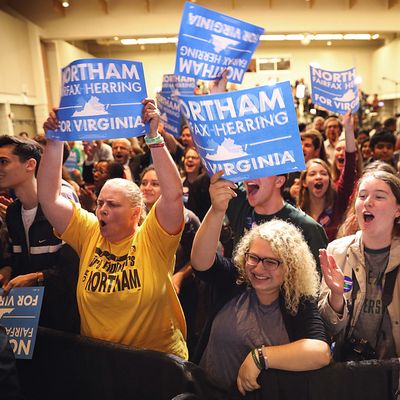
The election results on November 7 have reignited Democratic optimism about making big gains at the congressional and state levels in 2018. There are continuing signs of a nationwide pro-Democratic wave, but the Virginia results have renewed a very old debate: Is the South a lost cause for the Donkey Party?
There are, of course, pockets of Democratic support across the South that are reflected in Democratic (or competitive) House and state legislative districts. But control of statewide office and legislative chambers is another matter. At the moment, pending the final results from Virginia, Republicans control every state legislative chamber in the 11 former states of the Confederacy, plus two other states generally considered to be part of the South (Kentucky and Oklahoma). They hold 10 of the 13 governorships in these states (all but Louisiana, North Carolina, and Virginia), and all but 3 of the 26 seats in the U.S. Senate from the region (Democrats have Virginia’s two seats plus one in Florida).
Virginia is also a bit of a regional aberration: It is the only southern state to have gone Democratic in the last three presidential elections (a bit of an irony, since the Old Dominion was the most Republican of southern states before 2008, having voted for every GOP presidential candidate since Barry Goldwater).
But there are reasons to think the formula that made and has kept Virginia blue is replicable elsewhere in the region, as Politico notes:
[T]he nature of Virginia’s victories…gave Democrats the most long-term hope. Some of Lt. Gov. Ralph Northam’s biggest margins in the gubernatorial race came in suburban areas similar to the ones that dot North Carolina and Georgia, and down-ballot Democrats swept into power across those districts.
What makes Georgia, North Carolina, and Florida potentially winnable for Democrats is a combination of upscale suburban areas with college-educated voters and a relatively large minority vote. There is little in the Virginia numbers to reinforce any hopes of a Democratic resurgence among small-town or rural white voters. But Virginia’s 33 percent of the vote cast by nonwhite voters (in both 2016 and 2017) is exceeded by Georgia’s 40 percent (in 2016) and Florida’s 38 percent (also in 2016). North Carolina’s 30 percent is not far behind, either. And Texas, with 43 percent of voters being nonwhite, is potentially the sleeping giant for Democratic voters.
It’s worth noting that all upscale suburbs with highly educated white voters are not the same. Northern Virginia is heavily populated by federal workers, and an unusually high percentage (roughly half) of the state’s population was born elsewhere (only Florida, with 64 percent of the state’s population being born elsewhere, has a higher percentage of transplants among the southern states). Georgia, North Carolina, and Texas suburbs are more “southern” culturally, and more staunchly Republican in their voting habits.
Still, the building blocks for a Democratic majority are there in these states, and the most exciting thing about the Virginia results for Democrats in the South and everywhere else is that the Donkey Party may be overcoming its “midterm falloff” problem, wherein young and minority voters simply did not participate at rates commensurate with presidential contests.
The rest of the region is a much tougher proposition for Democrats, with Oklahoma, Kentucky, and Tennessee lacking a big enough minority vote to serve as a strong Democratic base, while Alabama, Arkansas, Louisiana, and Mississippi don’t have a relatively large concentration of college-educated suburbanites.
Democratic statewide wins in these states will require serious Republican divisions (as could happen in the South Carolina governor’s race and Senate races in Mississippi and Tennessee) or strokes of luck like the late-breaking sexual-abuse scandal that could consume Roy Moore’s candidacy in Alabama.
For all the Democratic optimism in the South, there are a limited number of GOP House seats in the region that are currently in play. Two are in not-all-that-southern and not-all-that-Republican South Florida. Another is Georgia’s sixth congressional district, made famous earlier this year by Jon Ossoff’s near miss. There are three Republican-held districts in Texas with large minority populations that are vulnerable in a wave election. And there’s one highly competitive district — now more competitive than ever — in suburban Northern Virginia. The other 39 House races rated as competitive by the Cook Political Report are outside the South.
If anti-Trump, anti-GOP sentiment increases nationally, other races could become competitive, of course.
“If there’s a wave, by God there will be a sea change in the South,” said Democratic National Committee Associate Chairman Jaime Harrison, a former party chair in South Carolina who’s been traveling through Southern states to evaluate state party infrastructures. “For the first time, we’re putting people and bodies and talent in races.”
In the absence of a wave, the southern Democrats could be making investments that will pay off down the road, as demographics continue to improve their prospects and intensive voter-registration efforts begin to pay off. In Georgia, for example, Democratic gubernatorial front-runner Stacey Abrams is staking her candidacy on a minority registration and turnout operation that may not win in 2018 but will certainly give her party a boost for years to come. And if they can succeed in fighting GOP voter-suppression efforts in the many states they control, the numbers will eventually turn in their direction.
Given Democratic demoralization in the region, running respectable campaigns and pulling off a few upsets can begin the kind of resurgence Democrats can now only dream about. It wouldn’t hurt if a few more Republican nominees turn out to have done some stupid things that are now coming back to bite them in the butt.






























